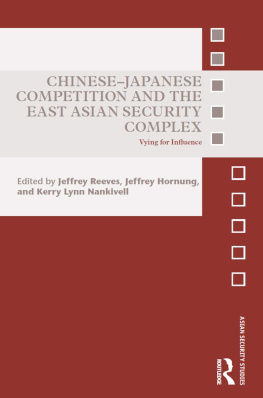Chinese Populations
in Contemporary
Southeast Asian Societies
Chinese Populations
in Contemporary
Southeast Asian Societies
Identities, Interdependence and
International Influence
Edited by
M. Jocelyn Armstrong
R. Warwick Armstrong
Kent Mulliner
LONDON AND NEW YORK
First Published in 2001
by Routledge
2 Park Square, Milton Park,
Abingdon, Oxon, OX14 4RN
270 Madison Ave, New York, NY 10016
Transferred to Digital Printing 2006
http://www.routledge.com
Editorial Matter 2001 M. Jocelyn Armstrong,
R. Warwick Armstrong and Kent Mulliner
Typeset in Garamond by LaserScript Ltd, Mitcham, Surrey
All rights reserved. No part of this book may be reprinted or reproduced or utilised in any form or by any electronic, mechanical, or other means, now known or hereafter invented, including photocopying and recording, or in any information storage or retrieval system, without permission in writing from the publishers.
British Library Cataloguing in Publication Data
A catalogue record of this book is available from the British Library
Library of Congress Cataloguing in Publication Data
A catalogue record for this book has been requested
ISBN 0-7007-1398-0
Publisher's Note
The publisher has gone to great lengths to ensure the quality of this reprint but points out that some imperfections in the original may be apparent
Contributors
M. Jocelyn Armstrong is an anthropologist in the Department of Community Health, University of Illinois, Urbana, Illinois, USA.
R. Warwick Armstrong is a geographer and epidemiologist in the Department of Community Health, University of Illinois, Urbana, Illinois, USA.
Theresa Chong Carino is a political scientist with the Amity Foundation, Hong Kong, China.
Sharon A. Carstens is an anthropologist in the Department of Anthropology, Portland State University, Portland, Oregon, USA.
Jean DeBernardi is an anthropologist in the Department of Anthropology, University of Alberta, Edmonton, Alberta, Canada.
Hong Liu is an historian in the Department of Chinese Studies, National University of Singapore, Singapore.
Kent Mulliner is a librarian in the Ohio University Libraries, Ohio University, Athens, Ohio, USA.
Judith Nagata is an anthropologist in the Department of Anthropology, York University, North York, Ontario, Canada.
Donald M. Nonini is an anthropologist in the Department of Anthropology, University of North Carolina, Chapel Hill, North Carolina, USA.
J. Norman Parmer is an historian at Trinity University, San Antonio, Texas, USA.
Leo Suryadinata is a political scientist in the Department of Political Science, National University of Singapore, Singapore.
Tan Chee Beng is an anthropologist in the Department of Anthropology, Chinese University of Hong Kong, Hong Kong, China.
Foreword
Southeast Asia's critical global role, economic, political and security, has been fully demonstrated in the twentieth century. In the second half of the century, three major developments had an especially profound international impact, beginning with the emergence of the Southeast Asian independent states from colonialism following the end of World War II, the extended and bitter conflict in Vietnam through the early 1970s, and the severe regional economic crisis of the late 1990s. The impact of these occurrences was momentous, globally, regionally and nationally, a reminder of the region's far-reaching influences.
Nor is Southeast Asia's notability likely to diminish in the twenty-first century, given its 500 million people (and rising), strategic geographical location, abundant natural resources and emerging industrial capacity. The total collective capability and importance of the region is certain to increase. Southeast Asia possesses the potentiality of becoming an even greater influence in global affairs.
Southeast Asia, however, is both one and many. Consider, for example, the complex political divisions and the spectacular cultural pluralism of the region. The region is home to ten independent political entities and the meeting grounds of diverse cultures. Another dimension is the ethnic/racial diversity. These and other different forces constitute both a strength and a weakness, depending upon the specific political unit and the vital factors of economic and political change. But there is no question that the region is composed of disparate cultures, peoples and political units.
The Chinese of Southeast Asia are one such important group. Chinese first entered the region more than 2000 years ago and it was among the first destinations for major Chinese immigration in the nineteenth and twentieth centuries. Today Southeast Asian Chinese constitute some 80 percent of Chinese who live outside China (the People's Republic of China, Taiwan and Hong Kong). Though no firm figures exist for the number of Chinese in Southeast Asia, estimates range from 5 to 6 million in Indonesia, 4.5 to 6 million in Thailand, 5.5 million in Malaysia, 2.7 million in Singapore, 1 million in the Philippines, and up to half a million in Cambodia. Their presence and influence, economic and otherwise, throughout Southeast Asia is undisputed.
Similar to Southeast Asia itself, the region's Chinese are both one and many. For example, even though the majority came mainly from two Chinese southern provinces (Guangdong and Fujian), the division by speech group alone is considerable Cantonese, Teochiu, Hokkien, Hainanese, Fuzhou and others. Southeast Asian Chinese have also varied according to conditions under which they departed from China and how they were received abroad; they also differ according to their economic roles. Finally, faced with rapidly changing local, national and international environments, Chinese in Southeast Asia have had to adjust and seek out new identities and roles.
With a realization of the complexities and disparities of this important region, the Center for East Asian and Pacific Studies of the University of Illinois at Urbana-Champaign as part of its ongoing commitment to and study of Southeast Asia, in association with the Shao Overseas Chinese Documentation and Research Center, Ohio University Libraries, Ohio University, Athens, and others, was pleased to sponsor an international conference in March 1997 on Southeast Asia, focusing on the Chinese populations. The conference, attended by scholars from China, Southeast Asia and North America, represented the best example of international academic cooperation, a joining of scholarly interests and sharing of research findings. The various studies are a major contribution to our further understanding of the issues facing contemporary Southeast Asia in general and the Southeast Asia Chinese in particular.















